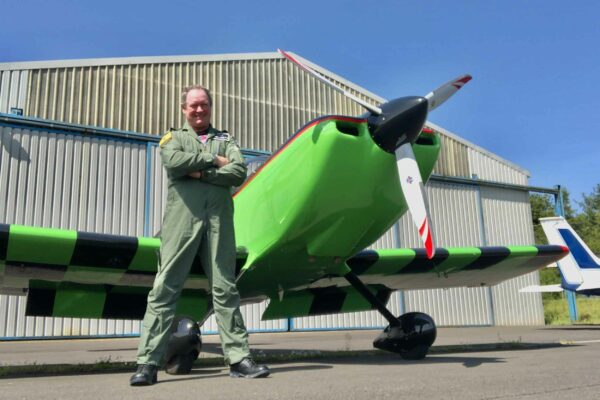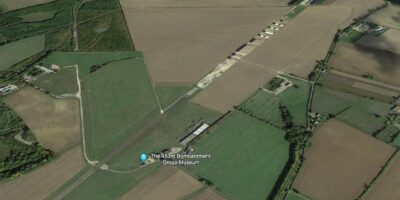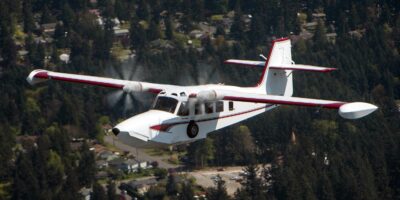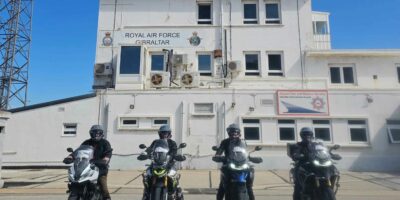It’s getting on for a year since I wrote about an unexpected bonus of Lockdown 1, which was a daily excuse to walk to my workshop, then to get on with my Jodel’s diesel engine conversion. This time though, the stroll across the yard doesn’t feel quite so guilt-free, and it isn’t every day. As someone said recently, ‘it’s all gone on long enough’… Lord knows what it’s like for those who have to bear the brunt of it. But… Lockdown 2 means I have now painted the engine mount white, added the LAA-compliant lateral strengtheners and reassembled the engine on the stand with its replica firewall. It’s pretty much ready to go on the aeroplane. That I can’t do though, until I replace the leaking fuel port fuel tank on my Messenger (another one is under construction by the same motorsport specialists who made the starboard one), and pop it over to North Coates where it will take the space currently occupied by the Jodel 1051 into which the diesel will go, once it arrives back in my hangar.
“That turbo installation was designed do a hundred thousand miles without cracking”
Much of the first lockdown was occupied with adapting and lengthening a set of original cowlings, of which fortunately, I had a couple of sets. They fit, almost, but because they were designed for a flat engine, even the Mk2B version just looks wrong. They will have to do while I prove the engine installation and then, if I have to move some ducts, I can attempt a sleek and slim set which flatter the inline engine’s dimensions. There was also the fact that making nice glass-fibre (or preferably epoxy) mouldings is a skill that needs to be acquired and honed. I’ve gained a small amount of that, but I’m still not exactly looking forward to the Mk3.
The engine was more familiar territory. Hot rodders have been using engines from another source forever, but in aviation, the choice is pretty limited, not to mention expensive. The all-aluminium, four-cylinder diesel intended for a Citroen C3 has never been in a car (I would happily have purchased one from a breakers), and is now equipped with an injection pump from a Peugeot 406, driven by belts from a Citroen Dispatch van and pulleys from a Volvo. The anti-vibration mounts on which it sits were designed for a Caterpillar’s cab, the flexy coupling to the reduction gear is mainly used to drive refrigeration pumps and the toothed belt is a common industrial item at common industrial prices. Each of the latter comes complete with a specification sheet detailing every possible aspect of its usage, and if I want one with more capability, I just give the manufacturer a different set of criteria and they come back with one that fits… The fuel filter and water trap is from a large tractor, the hoses and clips that connect the turbo are made for keen underbonnet customisers and available in a huge variety of sizes, angles and colours. Like the carbon fibre air filter can and the spun aluminium bellmouth – you get the picture. It all does the job for thousands of hours, and when it needs replacement, it doesn’t need a Form 1.
Using stuff and services from outside aviation is a large part of what has made this possible at all. That and access to a man who can translate my sketches into a CAD drawing, and the laser cutters who can make it to within thousandths – none of which was readily available 20 years ago – and of course the craftsmen who make race cars for a day job. It still seems a matter of wonder to me that Foxxy and his band of sorcerers can fabricate complex structures that look right and fit my little project perfectly – and do it almost overnight – but that’s motorsport for you. Crash at Silverstone on Sunday, back at Donington next Friday. It’s a way of life for them. And for me there’s the availability of a reasonably priced Mig welder, a Myford lathe no longer needed at a school, metal cutters, grinders, sanders and so on. Some of it cheaply Chinese, but
in reality, if you’re not using it daily for your trade, most of it
is good enough for light use. And it’s all online and arrives by courier within a few days. I’ve nearly learned how to use
most of it…
I still have to see if the engine works of course, but because the important parts have been developed at huge cost by industrial behemoths, I’m reasonably confident. And I haven’t modified the essentials. It was so tempting to get the band of metalworking wizards to create a tubular exhaust manifold to replace the cast iron one, move the turbo to down in the cowl, just like they did for the Porsche 956 and 962. Makes the pipework easier to route, and the ducting for the intercooler easier to accommodate. And it looks so very… aviation. “Don’t, just don’t…” said Mark. “That turbo installation was designed do a hundred thousand miles without cracking, leaking or falling off. And it’s already there, like the rest of the engine…” He’s in a position to know these things, so I’ve done as I was told. We’ll see. I’m still aiming to be at the LAA Rally, and now I’m more confident about which one…
Working vintage aircraft and cars make Mark particularly happy.
[email protected]







